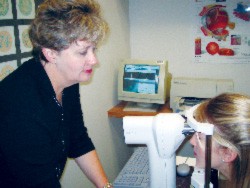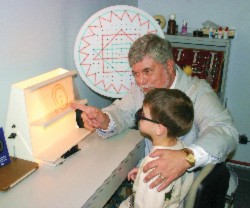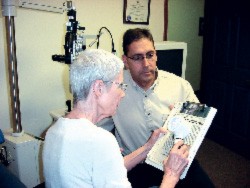Optometrist Glenda Secor, of Huntington Beach, Calif., hadnt planned on specializing in contact lenses. Rather, she fell into this niche in 1978, when she got her first job. She worked in a contact lens specialty practice that was affiliated with a hard contact lens lab that was owned by an optometrist. I had just graduated from optometry school, and it was just a job, she says.
When Dr. Secor realized there was no potential for advancement at the practice, she cut back her hours and, with the O.D.s approval, began traveling to the offices of the ophthalmologists who referred patients to the clinic for contact lens fittings and patient education. As her door-to-door optometry made her more and more popular, she was able to leave the contact lens specialty practice by 1982. I eventually became busier at one of the offices I traveled to. I really liked working there, so I dropped other days at other offices, she says. That office hired her full-time in 1982. In 1987, she pur- chased the contact lens portion of the practice, and shes been there ever since. What started out as just a job has become a passion.
When Dr. Secor realized there was no potential for advancement at the practice, she cut back her hours and, with the O.D.s approval, began traveling to the offices of the ophthalmologists who referred patients to the clinic for contact lens fittings and patient education. As her door-to-door optometry made her more and more popular, she was able to leave the contact lens specialty practice by 1982. I eventually became busier at one of the offices I traveled to. I really liked working there, so I dropped other days at other offices, she says. That office hired her full-time in 1982. In 1987, she pur- chased the contact lens portion of the practice, and shes been there ever since. What started out as just a job has become a passion.
 |
| Dr. Secor uses a corneal topographer to find out if this patient has an irregular cornea before fitting the patient with a contact lens. |
I have been a contact lens wear- er for 35 yearsshes myopic and presbyopicand contact lenses are fun, she says. I get to make people feel better about themselves and enable them to see the world in a whole different way.
Dr. Secors passion is another example of how a specialty can make an optometrist more marketable to a future employer and to patients who have varying needs.
In last months installment of Make Your Specialty Your Suc- cess, we talked with two O.D.s who used their computer vision and sports vision specialties to build their practices. In this second installment, we will discuss the contact lens, childrens vision and low vision specialties, and how your colleagues have used these concentrations to thrive.
Dr. Secors passion is another example of how a specialty can make an optometrist more marketable to a future employer and to patients who have varying needs.
In last months installment of Make Your Specialty Your Suc- cess, we talked with two O.D.s who used their computer vision and sports vision specialties to build their practices. In this second installment, we will discuss the contact lens, childrens vision and low vision specialties, and how your colleagues have used these concentrations to thrive.
Contact Lenses
Dr. Secors practice caters to children who are interested in contact lenses for cosmetic reasons, presbyopic patients who dont want to discontinue contact lens wear and patients who require therapeutic contact lenses.
The O.D. says she has grown her contact lens practice as a result of word-of-mouth referrals. One way she has marketed herself internally is through chair time. She says that although chair time can put a dent in her schedule, she realizes that talking to patients about what shes doing and why shes doing it is invaluable. Chair time implies that the patient-practitioner relationship is not built on commodity, and that professional care is valuable, she says.
|
Consider Contact Lenses |
| 22% of all adults 18+ years of age wear contact lenses at any time (part time, occasionally, all the time, etc.), according to Jobson Optical Research. Almost $2 million was spent on contact lenses in 2003, making up 11% of the $16.3 market made up of sales of: - lenses and lens treatments - eyeglass frames - contact lenses - sunglasses and sunglass clips sold through all optical retailers, according to Jobson Optical Research. |
The contact lens doc has also marketed herself by showing she is eager to tackle the tough cases. If a patient shows up and says, Ive been to five optometrists, and heres my history, you have be willing to really work with this patient in finding something that works for her, and you cant give up, she says. You have to be motivated, determined and passionate about the idea that you are going to prove those other practitioners wrong. Again, that will lead to word-of-mouth and referrals.
As a result, Dr. Secor has amassed a patient base of approximately 10,000 people. This large patient base, she says, has permitted her to conduct studies and participate in clinical investigations for such contact lens companies as CIBA Visiona form of external marketing. And, because of these relationships, Dr. Secor has been invited to lecture at several meetings and conferences, such as the Southeastern Congress of Optome- try (SECO).
One reason to consider a contact lens niche, Dr. Secor says, is because there will likely be a growth in the population of patients with postoperative complications. For example, she says, she is seeing a wave of post-RK patients who had the procedure 10 to 15 years ago. She says these patients are high hyperopes, high astigmats and have high oblique cylinders, and that they either cant or dont want to wear glasses. These patients are out there, and if youre involved in specialty fitting, theyre going to find you, she says.
As a result, Dr. Secor has amassed a patient base of approximately 10,000 people. This large patient base, she says, has permitted her to conduct studies and participate in clinical investigations for such contact lens companies as CIBA Visiona form of external marketing. And, because of these relationships, Dr. Secor has been invited to lecture at several meetings and conferences, such as the Southeastern Congress of Optome- try (SECO).
One reason to consider a contact lens niche, Dr. Secor says, is because there will likely be a growth in the population of patients with postoperative complications. For example, she says, she is seeing a wave of post-RK patients who had the procedure 10 to 15 years ago. She says these patients are high hyperopes, high astigmats and have high oblique cylinders, and that they either cant or dont want to wear glasses. These patients are out there, and if youre involved in specialty fitting, theyre going to find you, she says.
Childrens Vision
While he attended Illinois College of Optometry (ICO) in Chicago, optometrist Dominick Maino, of Harwood Heights, Ill., worked part-time as an orderly at Edward Hospital in Naperville, Ill. He was assigned to the emergency room, but because hes always had an affinity for children, hed help out in the pediatric wing whenever he got the chance.
Dr. Maino also did his work-study program at the Pediatric Binocular Vision Clinic at the Illinois Eye Institute. Interacting with children, their immediate families, extended families and their teachers and therapists really appealed to me, because by extending my professional boundaries, I was able to be a true primary care provider, he says.
 |
| Dr. Maino uses a vectogram to improve this patient"s fusional vergence. |
Upon graduating, Dr. Maino became ICOs first pediatric and binocular vision resident, and he began working part-time in private practice. After five years, he left the practice to participate in a faculty practice at ICO.
Four years later, a friend with whom Dr. Maino graduated invited him to join his practice, which specialized in contact lenses, geriatrics and low vision. I joined the practice to widen its scope of services, Dr. Maino says.
For about 15 years now, Dr. Maino has done that through internal and external marketing. Specif- ically, he has done four things to grow the pediatric portion of the practice.
Four years later, a friend with whom Dr. Maino graduated invited him to join his practice, which specialized in contact lenses, geriatrics and low vision. I joined the practice to widen its scope of services, Dr. Maino says.
For about 15 years now, Dr. Maino has done that through internal and external marketing. Specif- ically, he has done four things to grow the pediatric portion of the practice.
Firrst, Dr. Maino made sure that the entire officethe reception area, waiting area, exam rooms and dispensaryis child-friendly. In the waiting area, for instance, there are games, age-appropriate toys and reading material, he says. We also currently use educational vid- eos, which play on a continuous loop, to advertise the fact that we cater to kids.
Second, Dr. Maino has made sure the practices employees have a good rapport with children. My staff members have always known how to relate to children and their families, he says. This is important because if kids and their families like and feel comfortable with the staff, they will not only want to come back, but they will tell others about the staff, which brings in referrals.
The third internal marketing tool Dr. Maino has used is himself. He says that he tries to present himself as both competent and fun. With indirect ophthalmoscopy, for instance, the light is too bright, and I have to wear this scary looking apparatus on my head, he explains. To make the examination easier, I tell the child to look at my left ear, for instance, because sometimes it turns purple with orange stripes, and I have he or she let me know when it changes color.
|
Consider Childrens Vision |
| Vision problems affect one in 20 preschoolers and one in four school-age children, according to Prevent Blindness America. Approximately 20% of frames dispensed in 2003 were for children ages 7 to 17, according to Vision Service Plan. |
When eye drops are needed, he uses a spray instead because he knows his patients dont like having to lie down while someone pries their eye open. If you approach certain invasive aspects of optometry in a fun and therefore tolerable way, without sacrificing care, kids and their parents will want to come back, and theyll tell their friends about you, he says.
Dr. Maino also markets himself internally with photographs on his office wall that showcase himself and his interests. He also showcases his own photography. He says these photographs promote personal connections with his patients and their families, which he believes instills trust and confidence in his care and, again, leads to referrals.
Besides these internal methods, Dr. Maino has relied on these external methods:
Lectures. Dr. Maino has been invited to do in-service programs on developmental disorders for special educators, occupational, physical and speech language therapists, which he says has led to referrals. He also lectures at several meetings and conferences, such as the Middle Atlantic Optometrist Congress.
Dr. Maino suggests that O.D.s who are interested in lecturing should make a list of venues where they would like to talk, then send a lecture outline to those places of interest.
Practice newsletter. Dr. Mainos practice sends out a news- letter two or three times a year. Each newsletter usually includes information on pediatric optometry and vision therapy.
Web site. The practices Web site (www.nw.optometry.net) offers information about the practice, its services, the doctors, available products and vision in general. (You can also view Dr. Mainos photos.) The office Web site is just about the least expensive marketing tool you can get, he says. And, you want to update it frequently.
Dr. Maino says that he enjoys working with children because the experience is always challenging and fun. I enjoy having fun while solving unique problems and, at the same time, Im providing a much-needed service that few eye care professionals feel comfortable providing, he says.
Low Vision
Optometrist Kendall L. Krug, of Hays, Kan., had been in private general optometry practice a few years in the mid 1980s, when a local ophthalmologist asked him and the other three other O.D.s in the practice to learn low vision. The ophthalmologist saw many patients who had retinal disease, but he had no resources to whom he could refer them for vision rehabilitation.
So, Dr. Krug and his colleagues each spent half a day each month at a hospital-based low vision clinic. Dr. Krug also sought continuing education classes on low vision.
 |
| Dr. Krug shows a patient how to use a lighted magnifier to read. |
Soon after, Dr. Krug got married, sold his practice and moved to Topeka, Kan., where his wife attended medical school. He obtained a part-time job in Topeka as an associate at a general practice. The part-time situation enabled him to accept a part-time directors position at a nearby hospital-based low vision clinic a few months later.
Dr. Krug held both positions for the next five years, though he believes that he made the biggest impact as director of the low vision clinic. One of the ways he did so was to establish a referral relationship between the low vision clinic and the hospitals occupational therapy department. Because hands-on training with visual and other adaptive techniques was reimbursable through Medicare, he was able to take more time to train the patients and thus, increase successful outcomes.
After Dr. Krugs wife graduated from medical school, the two moved back to Hays where they each started their own practices. My practice was still in general optometry, but had more of an emphasis on low vision, he says. Hes been there ever since.
|
Consider Low Vision |
| There are currently more than 1 million Americans over 40 who are blind, and another 2.4 million who are visually impaired. These rates will double within the next 30 years due to aging baby boomers.1 |
Dr. Krug credits his former position as director at the low vision clinic for his ability to grow the low vision portion of his practice. A majority of the patients I have seen have come from retinal specialists, and I got to know those doctors pretty well, he says. So, when I restarted my practice, they still referred patients to me.
Today, he continues to garner low vision referrals by internally marketing himself. If you show a patient who has already been to three or four other eye doctors that they can read with some fairly simple rehab techniques or different types of aids, those patients will refer their friends, Dr. Krug says.
Dr. Krug also externally markets himself by:
Advertising in the local phone book.
Using a practice Web site (www.visionsource-drkrug.com), which averages about 20-25 hits per daymany of which he says come from the children of elderly parents who are looking for information and resources on low vision.
Speaking before various groups, such as state and regional associations for the blind.
I started doing speaking engagements when I was the director at the low vision clinic, and I became a member of my states optometry association, which has a low vision committee, he says. I also joined the low vision committee of my states optometric association, and I eventually moved up to the chairman position, which also got me more recognized, he says. Dr. Krug adds that if you have some success with your patients, theyll ask you to come and talk to Ameri- can Association for Retired People (AARP) chapters or low vision support groups. Such speaking engagements also bring in patients.
For those O.D.s interested in low vision who would like to lecture, he suggests you contact senior citizens organizationsarrange a phone call or send an informative letter to the key contact peopleas well as your state association for the blind, the American Council of the Blind (www.acb.org) and the National Federation of the Blind (www.nfb.org). Also, every state has a rehabilitation agency for the blind, so if you make yourself known to them, you can also get involved with seeing their patients, he says.
Dr. Krug says the AOAs low vision rehabilitation section, of which he is a council member, is developing a four-hour continuing education low vision program aimed at private practitioners, because, the number of low vision patients is going to skyrocket over the coming years, and the concern is that there are just not going to be enough practitioners out there doing it.
Whether by accident or because you feel an affinity for certain patient populations, if you establish a specialty and follow the marketing tips provided by your colleagues, you will most likely become known as the specialist to whom patients flock.
1. The Eye Disease Prevalence Research Group. Causes and prevalence of visual impairment among adults in the United States. Arch Opthalmol 2004 Apr;122(4):477-85.
Vol. No: 141:12Issue:
12/15/04

